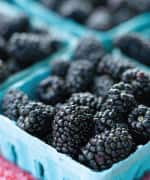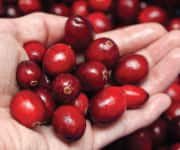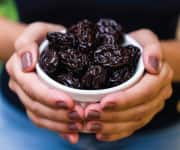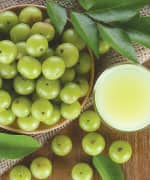Life Extension Magazine®
Plant-based compounds called phytonutrients promote healthy longevity and help reduce the risk for many age-related disorders.
An astonishing 90% of American adults fail to meet the daily recommended intake of fruits and vegetables rich in these plant nutrients.1
Research suggests that, worldwide, low consumption of vegetables results in about 800,000 deaths from heart disease and 200,000 deaths from stroke annually.
Low intake of fruit appears to cause about half a million deaths from heart disease every year and over one million stroke deaths.2
Studies indicate that even a modest increase in consumption of these plant foods could help prevent type II diabetes.3
We know it is important to regularly consume a wide variety of fruits and vegetables for optimal health. But that can be challenging.
Researchers have identified a dozen fruits and vegetables that, together, provide a rich array of highly beneficial phytonutrients.
Extracts and powders of these 12 foods deliver the phytonutrient equivalent of three servings of vegetables and two servings of fruit.
As an added benefit, these plant concentrates also provide food-based vitamins and minerals.
The Importance of Phytonutrients

Phytonutrients are health-promoting plant-based compounds.
They have a wide range of benefits, including anti-inflammatory activity, immune support, DNA repair, carcinogen detoxification, and reduction in damage from toxin exposures.4
These mechanisms function at the cellular level to arrest processes that can lead to diabetes, cancer, heart disease and other disorders.
Increased consumption of fruits and vegetables is associated with lower rates of various risk factors for chronic disease.5
The World Health Organization recommended an adequate intake of fruits and vegetables for the prevention of chronic diseases including obesity.6
For example, a diet rich in vegetables and fruits may:7
- Reduce the risk of heart disease and stroke,
- Help prevent some cancers, such as breast and lung cancer,
- Support eye health and help prevent macular degeneration and cataracts,
- Lower risk of digestive problems,
- Improve blood sugar levels and help prevent type II diabetes, and
- Help keep appetite in check.
But only 10% of American adults get the recommended daily intake of phytonutrient-rich fruits and vegetables.1
Even those who do may not realize that today’s industrial farming practices may deplete the soil of critical nutrients.
Some studies have shown that the vitamin and mineral content of fruits and vegetables has significantly declined since 1950.8
Some of today’s multi-nutrient formulas provide concentrated plant-derived phytonutrients. This helps those who want to boost their daily intake of beneficial plant compounds.
Best Documented Phytonutrients

In general, all fruits and vegetables contain some phytonutrients. But a wealth of research has allowed scientists to identify some of the most documented plant sources of health-promoting nutrients.
Quinoa Sprouts
Quinoa, a flowering plant from South America, may improve gut bacterial imbalance, body composition, celiac disease, lactose intolerance, and inflammatory bowel disorders.9 It shows strong antioxidant effects,10 and animal studies suggest quinoa might help prevent diabetes, obesity and dyslipidemias.11
Amla
Amla is a small berry grown in India that has become known for its “superfruit” benefits. A scientific review of preclinical studies found that amla functions as a free radical scavenger, anti-inflammatory, antimutagenic, and immune enhancer.12 These properties are efficacious in the prevention of certain cancers. Other clinical research showed that amla extract lowered levels of after-meal glucose, cholesterol, and triglycerides in both diabetics and nondiabetics.13 A review found evidence that amla and its extracts may be of value as part of a way to delay Alzheimer’s progression.14
Onion
Onion may help prevent obesity and improve liver function.15 Its compounds have been shown to have anticarcinogenic, antithrombotic, anti-asthmatic, and antimicrobial activity.16 Onions may affect many biologic processes that reduce cancer risk,17 and they may help to prevent cardiovascular disease.18
Grapeseed
Grapeseed has been shown to have anti-hypertensive effects. One review of 16 clinical trials found that grapeseed extract exerted significant improvements in blood pressure, especially among people with obesity and those with metabolic disorders.19
What you need to know
Phytonutrients
- Phytonutrients are beneficial chemicals produced by plants. They are often called phytochemicals.
- Plants use different phytonutrients to protect themselves from different sources of harm. Some protect against insects, for example, while others protect against radiation from the sun.
- Phytonutrients are abundant in fruits, vegetables, legumes, nuts, tea, whole grains, and many spices.
- Many phytonutrients, such as flavonoids and proanthocyanidins, give brightly colored fruits and vegetables their pigments. Other phytonutrient-rich foods, including onions and garlic, have little color. It’s important to include a full range of plant foods in your diet.
- Different phytonutrients provide a wide range of benefits in people, including antioxidant and anti-inflammatory activities, enhanced immunity, improved intercellular communication, DNA repair, reduced damage from exposure to toxins and carcinogens, and potentially a reduced risk of cancer and heart disease.4
Broccoli
Studies show that compounds in broccoli may protect against the risk of cancer via several mechanisms.20 This protective effect is so significant that scientists refer to broccoli as “green chemoprevention.”21 Research in animals suggests that broccoli may improve gut microbiota and attenuate colitis.22 In mice fed a typical Western diet, broccoli appears to inhibit the development of nonalcoholic fatty liver disease (NAFLD) and liver cancer.23
Palm Fruit
Palm fruit is rich in polyphenols and provides strong antioxidant activity.24 Animal research indicates that palm fruit phenolics may inhibit glucose absorption, reduce insulin resistance, and enhance insulin secretion, suggesting that it may help prevent or improve diabetes.25 A rat model suggested palm fruit supports large-intestine health.26
Elder Fruit
Cell research found that elder fruit inhibits infectious bronchitis virus at an early point in the replication process “probably by rendering the virus non-infectious.”27 A mouse model showed that it stimulated an immune response that prevented viral (flu) infection.28 European black elderberries were found to have antibacterial, antiviral, antidepressant, antitumor, and hypoglycemic properties, as well as the ability to decrease body fat.29 A review of five clinical studies found that elder fruit preparations taken within 48 hours of symptom onset may reduce the duration and severity of common cold and influenza symptoms in adults.30

Blackberry
Blackberry has been used extensively in herbal medicine.31 It provides diverse pharmacological effects that are antioxidant, anticarcinogenic, anti-inflammatory, antimicrobial, anti-diabetic, anti-diarrheal, and antiviral.32 Remarkably, one study found that, by protecting against oxidation and inflammation-induced injury, blackberry extracts prevented liver damage in rats and may alleviate non-alcoholic fatty liver disease (NAFLD).33
Sweet Cherry
After studying the phytonutrients in sweet cherry extracts, scientists have documented their suppression of key events in the carcinogenic process. This may be related to their effects against oxidative stress, chronic inflammation, deregulated cell proliferation and induction of beneficial apoptosis (programmed death of defective cells).34 This review of laboratory studies suggested sweet cherries have potential for adjuvant cancer treatment.
Laboratory studies also indicate sweet cherries may help counteract neurodegenerative disease through their upregulation of BDNF (brain-derived neurotrophic factor), a protein that promotes the survival of neurons.35

Cranberry
Cranberry extracts were shown in a preclinical study to suppress the growth of dangerous E. coli bacteria, while promoting beneficial bacteria.36 These berries have well-documented beneficial effects against urinary tract infections (UTIs), the second most common type of infections worldwide.37 Overall, cranberry phytonutrients display properties that are antibacterial, cardioprotective, and anti-cancer.38

Plum
Growing evidence suggests that dried plum has the potential “for preventing bone loss in postmenopausal women, with the potential for long-lasting bone-protective effects.”39 In a cell study, a plum flavonoid was shown to inhibit the early entry stage of the hepatitis C virus lifecycle, possibly by acting directly on the virus.40 Animal studies suggest plum extracts boost memory and learning41 and may inhibit the onset of epileptic seizures in rats.42
Persimmon
Persimmon compounds have antioxidant and anti-inflammatory properties and some evidence suggests that they may inhibit formation of skin wrinkles.43 Persimmon phytonutrients are known to mitigate oxidative damage and may regulate blood lipids and lower blood sugar—pointing to a protective effect against cardiovascular disorders and diabetes.44
PLANT-EXTRACT SUMMARY
Twelve healthy plant foods have been described so far.
Adding these to one’s daily diet makes a lot of scientific sense.
Another option is to ingest these fruits/vegetables in the form of extracts and powders that provide the same amount of:
- Flavonoids found in three servings of vegetables, and
- Proanthocyanidins found in two servings of fruit.
Flavonoids are a very large and diverse group of beneficial plant pigments.
Proanthocyanidins are a flavonoid subgroup.
These compounds help your body fight off damaging free radicals, reduce harmful inflammation, regulate cellular activity, support the immune system, and protect against dangerous stressors and toxins.4
New Human Study Shows Flavonoids Protect Brain Health

Ingestion of colorful fruits and vegetables containing flavonoids reduced the risk of cognitive decline in a human study published in July 2021.65
The study, published in the journal Neurology, showed that the intake of flavonoid-rich foods plays an important role in maintaining brain health.
A large cohort of people were followed for more than 20 years, with dietary questionnaires administered every four years, and subjective cognitive function assessed twice.
Among the highest 20% of flavonoid eaters there was a 20% lower risk of decline in thinking skills in people who consumed about 600 mg of flavonoids daily, compared to those in the lowest 20% who ate only about 150 mg a-day.
The researchers noted several beneficial properties of flavonoids that help protect the brain’s blood supply, which may slow the cognitive decline that can lead to dementia.
Individuals’ dietary habits are related to their brain health in later life, the study confirmed.
Food-Derived Vitamins
Phytonutrients aren’t the only beneficial ingredients found in fruits and vegetables. The following vitamins can also be extracted directly from food sources:
Carotenoids
The body can make its own vitamin A from carotenoids, but carotenoids have more diverse effects beyond ensuring adequate vitamin A status.
Three carotenoids—alpha-carotene, beta-carotene, and gamma-carotene—can be derived from sustainably sourced Malaysian palm fruit. They are delicately extracted using a low-temperature process called molecular distillation.
Vitamin A and its carotenoid precursors help support vision, cellular differentiation and proliferation, immune system integrity, thyroid hormone formation, and healthy lung, kidney, skin, and mucous membranes. It also contributes to the growth of bone, teeth, and soft tissue.45-47

Vitamin C
A source of vitamin C is amla fruit, also known as Indian gooseberry.
Vitamin C is associated with immune-system health. It protects against oxidative stress and stimulates the production and function of white blood cells.48,49 Vitamin C is also vital to the formation of collagen, the critical structural protein in arterial walls, skin, bones, and teeth.49
Vitamin D
Vitamin D3 is mostly found in animal sources. As a result, many vegan-friendly vitamin D formulas contain vitamin D2, which is inferior to D3 for maintaining blood levels.50
However, vitamin D3 can also be isolated from non-GMO, organically farmed algae, allowing vegans to use the superior D3 form.
Vitamin D is best known for its support of strong bones. It also promotes healthy cell division and immune function51,52 and plays a key role in lung, brain, cardiovascular, and nervous system health.53

Vitamin E
Sunflowers are an abundant source of vitamin E.
Vitamin E can help boost immune function, inhibit inflammation, reduce oxidative stress, and promote healthy brain, vision, blood, and skin.54-56
B Vitamins
Some B vitamins can be derived from organic quinoa sprouts. The quinoa is placed in a nutrient-rich solution so that during germination, the sprouts concentrate the nutrients into their cells and convert them into active B-vitamin forms.
B vitamins are necessary for DNA/RNA synthesis and repair, proper immune function, neurotransmitter synthesis, and healthy DNA methylation (a process that keeps gene expression working properly).57
Adults with low B-vitamin status are at increased risk for developing age-related disorders, particularly cognitive and cardiovascular diseases.57
Minerals
The minerals iodine, magnesium, zinc, selenium, manganese, chromium, and molybdenum should be included in any plant-based formula.
These minerals are needed for healthy metabolism, thyroid function, wound healing, bone strength, immune responses, enzymatic reactions throughout the body, and much more.58-64
It is vital to get sufficient intake of minerals, along with vitamins and phytonutrients, on a regular basis.
Summary

Phytonutrients are plant compounds that promote healthy longevity and help protect against chronic diseases and premature aging.
Scientists have found that by combining together the extracts and powders of 12 key foods, it is possible to get the phytonutrient equivalent of three servings of vegetables and two servings of fruit.
An optimal food-based multivitamin may also provide key vitamins and minerals naturally found in fruits and vegetables.
If you have any questions on the scientific content of this article, please call a Life Extension® Wellness Specialist at 1-866-864-3027.
References
- Lee-Kwan SH, Moore LV, Blanck HM, et al. Disparities in State-Specific Adult Fruit and Vegetable Consumption - United States, 2015. MMWR Morb Mortal Wkly Rep. 2017 Nov 17;66(45):1241-7.
- Available at: https://www.medicalnewstoday.com/articles/325459. Accessed July 29, 2021.
- Available at: https://www.bmj.com/company/newsroom/higher-fruit-vegetable-and-whole-grain-intake-linked-to-lower-risk-of-diabetes/. Accessed July 29, 2021.
- Data on file.
- Boeing H, Bechthold A, Bub A, et al. Critical review: vegetables and fruit in the prevention of chronic diseases. Eur J Nutr. 2012 Sep;51(6):637-63.
- Available at: https://www.who.int/dietphysicalactivity/publications/trs916/en/gsfao_introduction.pdf. Accessed July 29, 2021.
- Available at: https://www.hsph.harvard.edu/nutritionsource/what-should-you-eat/vegetables-and-fruits/. Accessed July 29, 2021.
- Davis DR, Epp MD, Riordan HD. Changes in USDA food composition data for 43 garden crops, 1950 to 1999. J Am Coll Nutr. 2004 Dec;23(6):669-82.
- Ugural A, Akyol A. Can pseudocereals modulate microbiota by functioning as probiotics or prebiotics? Crit Rev Food Sci Nutr. 2020 Nov 16:1-15.
- Al-Qabba MM, El-Mowafy MA, Althwab SA, et al. Phenolic Profile, Antioxidant Activity, and Ameliorating Efficacy of Chenopodium quinoa Sprouts against CCl4-Induced Oxidative Stress in Rats. Nutrients. 2020 Sep 23;12(10):2904.
- Lopes CO, Barcelos MFP, Vieira CNG, et al. Effects of sprouted and fermented quinoa (Chenopodium quinoa) on glycemic index of diet and biochemical parameters of blood of Wistar rats fed high carbohydrate diet. J Food Sci Technol. 2019 Jan;56(1):40-8.
- Baliga MS, Dsouza JJ. Amla (Emblica officinalis Gaertn), a wonder berry in the treatment and prevention of cancer. Eur J Cancer Prev. 2011 May;20(3):225-39.
- Akhtar MS, Ramzan A, Ali A, et al. Effect of Amla fruit (Emblica officinalis Gaertn.) on blood glucose and lipid profile of normal subjects and type 2 diabetic patients. Int J Food Sci Nutr. 2011 Sep;62(6):609-16.
- Teimouri E, Rainey-Smith SR, Bharadwaj P, et al. Amla Therapy as a Potential Modulator of Alzheimer’s Disease Risk Factors and Physiological Change. J Alzheimers Dis. 2020;74(3):713-33.
- Nishimura M, Muro T, Kobori M, et al. Effect of Daily Ingestion of Quercetin-Rich Onion Powder for 12 Weeks on Visceral Fat: A Randomised, Double-Blind, Placebo-Controlled, Parallel-Group Study. Nutrients. 2020;12(1):91.
- Griffiths G, Trueman L, Crowther T, et al. Onions--a global benefit to health. Phytother Res. 2002 Nov;16(7):603-15.
- Nicastro HL, Ross SA, Milner JA. Garlic and onions: their cancer prevention properties. Cancer Prev Res (Phila). 2015 Mar;8(3):181-9.
- Ali M, Thomson M, Afzal M. Garlic and onions: their effect on eicosanoid metabolism and its clinical relevance. Prostaglandins Leukot Essent Fatty Acids. 2000 Feb;62(2):55-73.
- Zhang H, Liu S, Li L, et al. The impact of grape seed extract treatment on blood pressure changes: A meta-analysis of 16 randomized controlled trials. Medicine (Baltimore). 2016 Aug;95(33):e4247.
- Fahey JW, Zhang Y, Talalay P. Broccoli sprouts: an exceptionally rich source of inducers of enzymes that protect against chemical carcinogens. Proc Natl Acad Sci U S A. 1997 Sep 16;94(19):10367-72.
- Bayat Mokhtari R, Baluch N, Homayouni TS, et al. The role of Sulforaphane in cancer chemoprevention and health benefits: a mini-review. J Cell Commun Signal. 2018 Mar;12(1):91-101.
- Hubbard TD, Murray IA, Nichols RG, et al. Dietary Broccoli Impacts Microbial Community Structure and Attenuates Chemically Induced Colitis in Mice in an Ah receptor dependent manner. J Funct Foods. 2017 Oct;37:685-98.
- Chen YJ, Wallig MA, Jeffery EH. Dietary Broccoli Lessens Development of Fatty Liver and Liver Cancer in Mice Given Diethylnitrosamine and Fed a Western or Control Diet. J Nutr. 2016 Mar;146(3):542-50.
- Ma C, Dunshea FR, Suleria HAR. LC-ESI-QTOF/MS Characterization of Phenolic Compounds in Palm Fruits (Jelly and Fishtail Palm) and Their Potential Antioxidant Activities. Antioxidants (Basel). 2019 Oct 14;8(10).
- Bolsinger J, Pronczuk A, Sambanthamurthi R, et al. Anti-diabetic effects of palm fruit juice in the Nile rat (Arvicanthis niloticus). J Nutr Sci. 2014;3:e5.
- Conlon MA, Sambanthamurthi R, Tan YA, et al. Consumption of an Oil Palm Fruit Extract Promotes Large Bowel Health in Rats. Nutrients. 2020 Feb 28;12(3):644.
- Chen C, Zuckerman DM, Brantley S, et al. Sambucus nigra extracts inhibit infectious bronchitis virus at an early point during replication. BMC Vet Res. 2014 Jan 16;10:24.
- Kinoshita E, Hayashi K, Katayama H, et al. Anti-influenza virus effects of elderberry juice and its fractions. Biosci Biotechnol Biochem. 2012;76(9):1633-8.
- Mlynarczyk K, Walkowiak-Tomczak D, Lysiak GP. Bioactive properties of Sambucus nigra L. as a functional ingredient for food and pharmaceutical industry. J Funct Foods. 2018 Jan;40:377-90.
- Harnett J, Oakes K, Care J, et al. The effects of Sambucus nigra berry on acute respiratory viral infections: A rapid review of clinical studies. Adv Integr Med. 2020 Dec;7(4):240-6.
- Verma R, Gangrade T, Punasiya R, et al. Rubus fruticosus (blackberry) use as an herbal medicine. Pharmacogn Rev. 2014 Jul;8(16):101-4.
- Zia-Ul-Haq M, Riaz M, De Feo V, et al. Rubus fruticosus L.: constituents, biological activities and health related uses. Molecules. 2014 Jul 28;19(8):10998-1029.
- Park S, Cho SM, Jin BR, et al. Mixture of blackberry leaf and fruit extracts alleviates non-alcoholic steatosis, enhances intestinal integrity, and increases Lactobacillus and Akkermansia in rats. Exp Biol Med (Maywood). 2019 Dec;244(18):1629-41.
- Fonseca LRS, Silva GR, Luis A, et al. Sweet Cherries as Anti-Cancer Agents: From Bioactive Compounds to Function. Molecules. 2021 May 15;26(10).
- Antognoni F, Potente G, Mandrioli R, et al. Fruit Quality Characterization of New Sweet Cherry Cultivars as a Good Source of Bioactive Phenolic Compounds with Antioxidant and Neuroprotective Potential. Antioxidants (Basel). 2020 Jul 28;9(8).
- O’Connor K, Morrissette M, Strandwitz P, et al. Cranberry extracts promote growth of Bacteroidaceae and decrease abundance of Enterobacteriaceae in a human gut simulator model. PLoS One. 2019;14(11):e0224836.
- Gonzalez de Llano D, Moreno-Arribas MV, Bartolome B. Cranberry Polyphenols and Prevention against Urinary Tract Infections: Relevant Considerations. Molecules. 2020 Aug 1;25(15).
- Jurikova T, Skrovankova S, Mlcek J, et al. Bioactive Compounds, Antioxidant Activity, and Biological Effects of European Cranberry (Vaccinium oxycoccos). Molecules. 2018 Dec 21;24(1).
- Arjmandi BH, Johnson SA, Pourafshar S, et al. Bone-Protective Effects of Dried Plum in Postmenopausal Women: Efficacy and Possible Mechanisms. Nutrients. 2017 May 14;9(5).
- Bose M, Kamra M, Mullick R, et al. Identification of a flavonoid isolated from plum (Prunus domestica) as a potent inhibitor of Hepatitis C virus entry. Sci Rep. 2017 Jun 21;7(1):3965.
- Shahidi S, Setareye S, Mahmoodi M. Effect of Prunus domestica L. (mirabelle) on learning and memory in mice. Anc Sci Life. 2013 Jan;32(3):139-43.
- Youssef FS, Menze ET, Ashour ML. A Potent Lignan from Prunes Alleviates Inflammation and Oxidative Stress in Lithium/Pilocarpine-Induced Epileptic Seizures in Rats. Antioxidants (Basel). 2020 Jul 2;9(7).
- Hwang KC, Shin HY, Kim WJ, et al. Effects of a High-Molecular-Weight Polysaccharides Isolated from Korean Persimmon on the Antioxidant, Anti-Inflammatory, and Antiwrinkle Activity. Molecules. 2021 Mar 13;26(6):1600.
- Butt MS, Sultan MT, Aziz M, et al. Persimmon (Diospyros kaki) fruit: hidden phytochemicals and health claims. EXCLI J. 2015;14:542-61.
- Data on file.
- Available at: https://www.hsph.harvard.edu/nutritionsource/vitamin-a/. Accessed July 16, 2021.
- Available at: https://www.mayoclinic.org/drugs-supplements-vitamin-a/art-20365945. Accessed July 16, 2021.
- Lykkesfeldt J, Michels AJ, Frei B. Vitamin C. Adv Nutr. 2014 Jan 1;5(1):16-8.
- Data on file.
- Tripkovic L, Lambert H, Hart K, et al. Comparison of vitamin D(2) and vitamin D(3) supplementation in raising serum 25-hydroxyvitamin D status: a systematic review and meta-analysis. Am J Clin Nutr. 2012 Jun;95(6):1357-64.
- Wang H, Chen W, Li D, et al. Vitamin D and Chronic Diseases. Aging Dis. 2017 May;8(3):346-53.
- Christakos S, Hewison M, Gardner DG, et al. Vitamin D: beyond bone. Ann N Y Acad Sci. 2013 May;1287:45-58.
- Data on file.
- Lewis ED, Meydani SN, Wu D. Regulatory role of vitamin E in the immune system and inflammation. IUBMB Life. 2019 Apr;71(4):487-94.
- Szymanska R, Nowicka B, Kruk J. Vitamin E - Occurrence, Biosynthesis by Plants and Functions in Human Nutrition. Mini Rev Med Chem. 2017;17(12):1039-52.
- Tantavisut S, Tanavalee A, Honsawek S, et al. Effect of vitamin E on oxidative stress level in blood, synovial fluid, and synovial tissue in severe knee osteoarthritis: a randomized controlled study. BMC Musculoskelet Disord. 2017 Jun 29;18(1):281.
- Mikkelsen K, Apostolopoulos V. B Vitamins and Ageing. Subcell Biochem. 2018;90:451-70.
- Data on file.
- Data on file.
- Data on file.
- Data on file.
- Data on file.
- Data on file.
- Data on file.
- Yeh T-S, Yuan C, Ascherio A, et al. Long-term Dietary Flavonoid Intake and Subjective Cognitive Decline in US Men and Women. Neurology. 2021 Jul 28.

